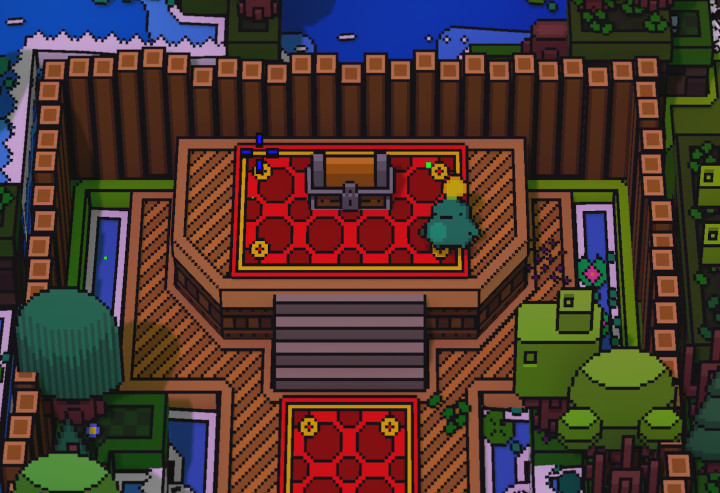
I’ve been following the development of an indie roguelite called Planet of Gloob for a while now. Not only does it seem to blend elements from a lot of my favorite video games, like The Binding of Isaac, The Legend of Zelda, and Don’t Starve, but Planet of Gloob has left me transfixed by its gorgeous pixel art and adorable visual style.
The game’s official Twitter account shares a nonstop barrage of intoxicatingly beautiful animations. For example, this one:
And this one:
As someone who always wants more information about absolutely everything, I decided to reach out to the game’s creator, Dylan Irwin, to find out more about the game. Irwin graciously agreed to answer my questions, and I’ve posted our conversation below.
Here is the full Planet of Gloob interview with Dylan Irwin (edited very briefly for format and flow).
What are some of the inspirations for Planet of Gloob?
I’d probably say the main inspirations are Pokémon and various other roguelites. I took a lot of inspiration for the team-building/monster-catching mechanics in Planet of Gloob from Pokémon. Roguelites such as Nuclear Throne, Enter the Gungeon, and The Binding of Isaac got me into the roguelite genre. I really enjoy the fast-paced gameplay of Nuclear Throne, the atmosphere of Gungeon, and the items of Isaac — and I hope to incorporate some of those aspects into Planet of Gloob.
What are some of your favorite video games? (These don’t have to be games that influenced you, just games you really enjoy.)
My favorite of all time would probably be The Legend of Zelda: Ocarina of Time. I also like (in no particular order) SSX, Super Mario Sunshine, Trackmania, Minecraft, and pretty much the whole Zelda franchise.
Planet of Gloob looks absolutely gorgeous. You’ve clearly put a lot of time and thought into how this world should look. What have you been using as visual references, or are you sort of just putting what’s inside your head into code?
I try to keep the art, especially for the environment, as simple as possible. It evolved over time. Most of my textures are just simple repeating patterns. I originally started with no black outlines at all except for on the characters, but gradually started outlining more and more until eventually pretty much everything was outlined. The game also started out 2D, but when I was trying to implement a fake third dimension into the game, I decided it would be easier to just commit to making the entire world 3D. I try to make everything look like it was a 2D game at first glance.
My biggest inspiration for the characters would have to be Nuclear Throne. I referenced their character design a lot early on, but started relying on it less and less. I’ve added more bounce to all the sprites over time as I learn. For the environment, I often look to Paper Mario to see how they handled certain aspects of the environment. Most of the objects in the game are made up of overlapping sprites which are similar to sheets of paper, and Paper Mario is the closest thing I could find to that.
Overall, my art style is a product of endless revisions, and will likely continue to change.
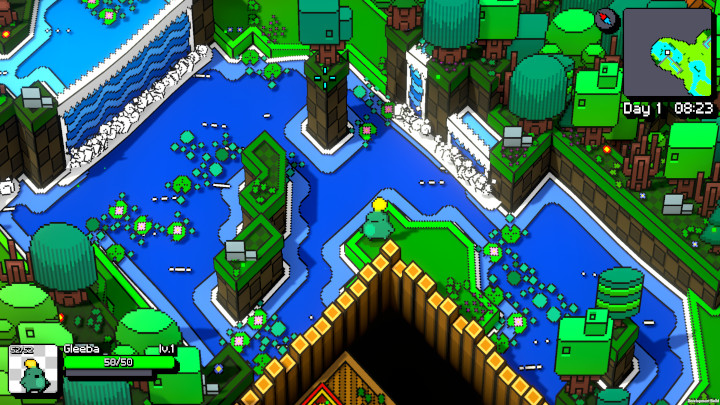
I’m still a bit fuzzy on what the gameplay loop is in Planet of Gloob. Could you describe that a bit?
The gameplay loop will be fairly standard for a roguelite (at least at the time of writing this). You choose a team of up to three creatures and try to clear each island and defeat the final boss. If all three of your creatures die, you start over.
I haven’t finalized most of the details yet, but I expect the main focus of most players will be trying to catch all of the creatures, and uncovering secrets. There will be permanent progression in between runs in the form of leveling your creatures, unlocking new attacks and items, and changes to the island generation.
It looks like there’s a variety of playable characters in the footage I’ve seen. Can you talk a bit about these characters and how they play? Are there strengths and weaknesses to each one, or are the differences purely visual?
Every creature you fight against in the game can be caught and added to your team. Each creature can have up to two attacks, one for right click and one for left click (or right and left triggers on a controller).
While the creatures in the wild will only have one signature attack, after you catch them they can learn new moves. Each creature will have unique move pools and some will have attacks exclusive to them. New moves can be learned through leveling up or can be purchased with a permanent currency that persists between runs. Each creature will also have a movement ability such as rolling, flying, digging under ground, teleporting, or double jumping which consume extra energy but are useful for avoiding attacks.
There are different stats for health, attack, defense, speed, energy, and luck. Similar to IVs in Pokémon, stats will also vary from individual to individual.
Each creature also has up to two elemental typings which effect which moves they can learn and how effective attacks are on them.
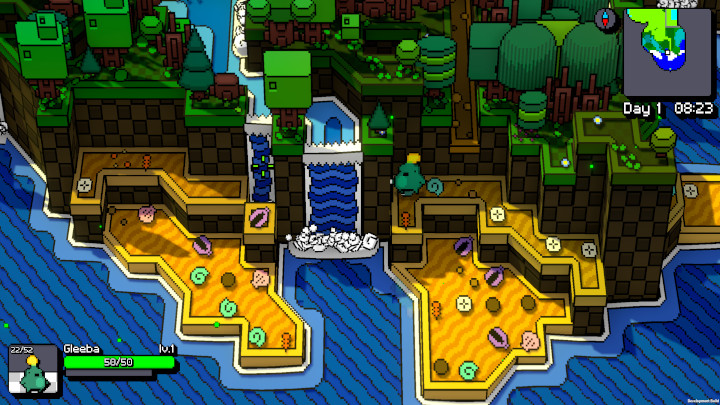
Do you have a favorite character in Planet of Gloob?
At the moment, it’s gotta be the Gleeba because he’s the chunkiest.
The game is described as a roguelite. This means there’s some level of procedural generation, I would assume. How does this work in Planet of Gloob? Were there any technical challenges involved in implementing procedural generation?
The stages in the game are procedurally generated islands, each with a different biome. Everything is procedurally generated except for the premade rooms which get placed on the island.
Rather than having a proper dungeon with rooms and corridors like in Gungeon, or a completely open environment like Nuclear Throne, I opted to combine both techniques. There are open sections of the island that connect to smaller mini “dungeons,” which are made up of chains of rooms that must be cleared one by one. Walls in the wild are completely destructible, but dungeon walls cannot be broken.
I hope that by having both styles of generation I can give the player more freedom while also keeping a bit of control over the flow of each island. I was worried that with a completely open concept, a player could simply run by all of the enemies to get to chests or find other exploits.
I faced many technical challenges while coming up with an island generation algorithm I liked, and I’m sure I’ll face more down the road. One of the biggest challenges I faced was memory management. Before I knew about procedural meshing, each tile was an individual GameObject, which consumed tons of memory and also destroyed performance. After implementing procedural meshing, I realized that I also needed to be able to change the mesh and mesh collider at runtime without causing any freezing or stuttering which was another huge problem. I ended up using a chunking system similar to the one in Minecraft to speed up mesh updates while switching from a mesh collider to individual box colliders for each tile. Combined with extra bookkeeping to keep track of each tile’s index in the mesh, this method increased memory usage a bit but made updates extremely fast.
I’ve asked other developers this question before, but I’m curious to hear your thoughts on it. What do you think it is about the roguelike genre that makes it so popular to this day, despite being more than four decades old?
Personally, I got into the genre because of how easy it is to pickup a roguelike and play. You don’t really need to worry about where you are in a story or remember any characters because they get reset every run. I also like that, for the most part, roguelikes don’t seem to takes themselves too seriously. They aren’t trying to get you immersed in some big story or world and don’t try to hide the fact that they are video games. I also love the freedom of roguelikes — you don’t need to follow a quest, you just get right into the action however you like.
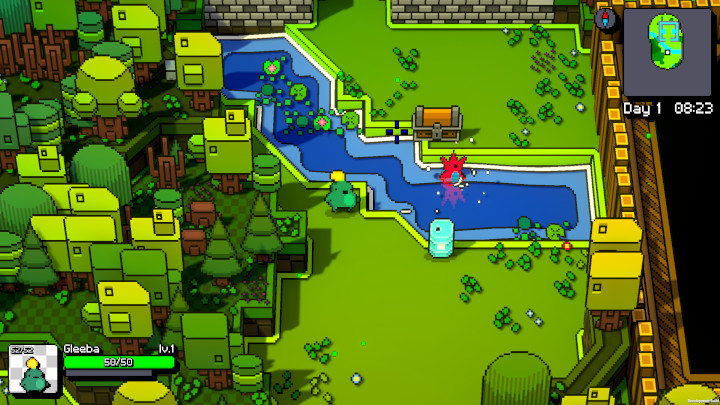
What would you say is Planet of Gloob‘s defining feature?
The defining feature of Planet of Gloob would definitely be the catching mechanic. Everything that you can do, the enemies can do, and vice versa. Enemies use the same attacks and items as you and have the same exact stats as you.
What are the biggest development challenges you’ve faced with Planet of Gloob?
The biggest technical challenge was, and still is, the goop system. The goop system allows most surfaces to be covered in a “fluid,” such as blood, water, oil, etc. which can be interacted with in different ways (such as oil burning or water freezing).
For each tile, there are 64 goop “nodes” which can be activated, so it takes way more memory and processing power to update than the regular terrain. By only creating nodes when they are needed and deleting them when they are no longer needed, I’ve been able to get the memory usage under control.
The biggest issue that still remains is handling thousands of nodes updating at the same time without slowing the system down. I’m still experimenting with ways to optimize this, but the performance is still acceptable for the vast majority of cases.
Other than that, designing systems to work with online multiplayer has been a challenge, but nothing that can’t be solved so far.
Have you had to cut any features due to time/scope?
I’m likely going to have to scrap splitscreen for performance reasons, or limit spliscreen to two players. Other than that, I haven’t had to cut anything too big yet.
What are your release plans for Planet of Gloob? Are you planning on doing a beta or Early Access version? When can the general public expect to have a playable build to enjoy?
I’m hoping to release a public demo within a month or two. Other than that, I haven’t set a solid plan for release yet but I am considering Early Access.
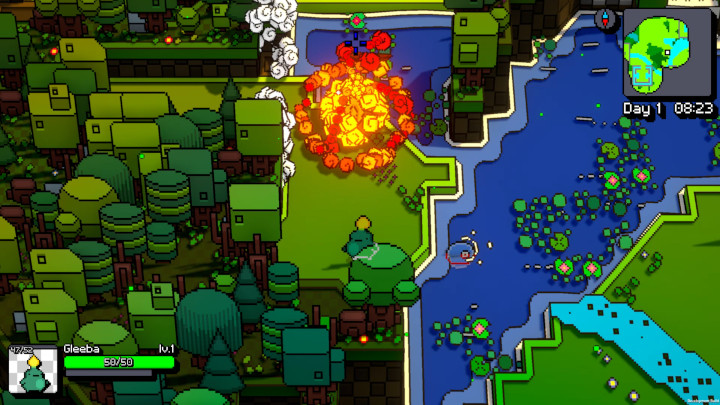
Are there any shoutouts you’d like to give before we wrap up this interview?
Shoutout to the fans, I love ya’ll.
Thanks so much for taking the time to chat with me about Planet of Gloob. I definitely look forward to getting my hands on the game and experiencing it firsthand instead of simply drooling over the beautiful animations!
